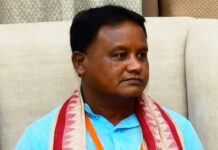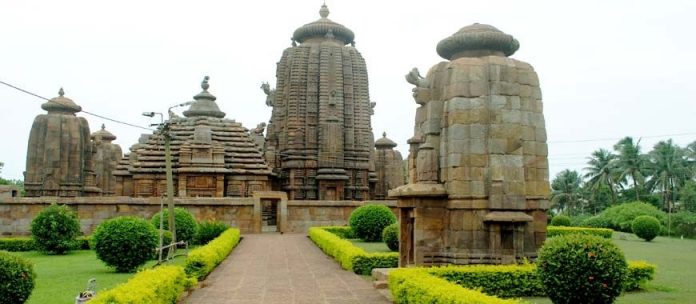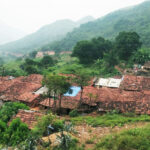Temple Brahmeswar a typical Orissan temple of 18.29 metres high assigned to 11th century is yet another milestone. in the temple building activity of Orissa. The slab ceiling the interior is carved as an inverted lotus with serpentine figures at comers. The processions of armed infantry, cavalry and elephants animal & birds adorn the mezes of the structure. Besides the other four temples in the four comers of the enclosure the sacred Brahma Kunda is located on the western side.
The Brahmesvara temple is of singular importance in the history of Orissan architecture, as it is the only temple at Bhubaneswar which can be dated with some amount of precision According to an inscription, now lost, it was built by Kolavati, mother of kind Udyota Kesari, in the eighteenth year of the latter’s reign which may be placed about the middle of the eleventh century AD. 5 Situated at a locality known as Siddhatirtha at Ekamra. Within an enclosure and with four subsidiary shrines at the four comers it makes regular panchayatana roup. In plan the temple is pancha-ratha and the bada consists of five elements as in the typical Orissan temple. The other typical features, deulacharanis above the bisama, the khapuri, the kalasa and the ayudha over the amalakasilla, are all there, as in the Siddhesvara and the Kedaresvara. But what indicate the Brahmesvara as an advance on the design of the other two are the contour of the rekha and the shape and composition of the pidha. Apart orm its softened appearance due to the rounding off of the sharp edges, the rekha gandi in the Brahmeswara, in stead of showing a gradual inward curve, rises almost perpendicularly up to a great height and takes a pronounced bend only towards the top, a contour that is not for off ITom that of the celebrated Lingaraja at Bhubaneswar. The jagamohana, though approximating in shape to those of the Muketeswar, the Siddheswara and the Kedareswara, has a new and significant feature supplying a definite connection with the future development of the typical pidha deula. The top is surmounted by a social member crowned further by the amalaka-sila and the auspicious jar, exactly as in the jagamohanas 0 the typical Orissan temples. But the different elements of the superstructure still show rather an assortment of individual members without any conscious attempt at co-ordination and integration that are to come later. In its characteristic features and appearance the Brahmeswara is the nearest approach to the great Lingaraja which is typical of all that is best in the Orissan type of temple.
As in a typical Orissan temple, the deul has a five-old division in the bada: the pabhaga and the varanda are made respectively of five and three moulding, all richly carved: the jangha is divided into two by a single broad moulding. The comer and intermediary rathas of the lower jangha have, as usual, insets of khakhara-mundis and vidalas. The central niches of the comer khakhara-mundis contain dikapalas, seated on their respective mounts, while those of the intermediary ones have mostly different forms of Siva like Aja-Ekapada, Andhakasura-vadha-murti, Ardhanarisvara, Nataraja and Bhairava in his skeleton-form. The corresponding spaces of the upper jangha have pidhamundis and kanyas, slender as in the Rajarani temple and often in captivating poses such as looking at her reflection on a mirror on the west side. The themes of the niches of the pidha-mundis are mostly erotic couples and kanyas and very rarely deities like the fourarmed Nataraja playing on a vina above the bull on the west face.
The lowest part of the gandi is relieved with a row of small anga-sikharas, one on each paga ecept the frontal raha, where there is a group 0 five, of which two are of the pidha type. The kanika-paga is divided into five planes by oblon bhumi-amlas crowning a set of five bhumi-varandis. The decoration of the gandi presents some novel designs not found in other temples. The kanika-paga is distinguished by a vertical band of creeper containing animal-figures. The anuratha has a succession of khakhara-mundis, the mastaka of which is relieved with a stylized bho, this being the most recurrent motif in the embellishment of this temple. The decoration of the raha above the anga-sikharas takes the form of a bho crowned by a rampant lion, not on elephant but on a krti-mukha, which is rather unusual; above this is a central arabesque band, the frontal raha having a figure of Nataraja in addition. The mastaka consists of the beki, the amla supported by four squat figures, khapuri and kalasa, the trident crowning all.
The jagamohana has a three-fold division in its bada, with five plain mouldings for the pabhaga. The comer and intermediary rathas of its jangha are relieved with khakhara-mundis and vidalas, the latter having on their top either a couple r a kanya. Like the deul, the niches of the comer khakhara-mundis contain seated figures of eight dikpalas. The balusters of the windows on the central projections of the north and south faces are carved with female figures in various graceful poses. The central panel above the north window depicts a female dancer accompanied by musicians, the subject of the corresponding space on the south side being a gathering in ITont of a preceptor. The varanda is a single broad moulding, remarkable for an animated meze of the procession of various animals and birds.
The pidhas are arranged in a continuous succession without any break. The mastaka contains all the component members of a full-fleded Orissan jagam?hana, viz., beki, ghanta, amla-beki, amla, khapuri and kalasa.
The door-frame is beautifully carved in bands of floral and creeper motifs and flying figures, with the usual Saiva door-keepers standing above double vidalas at the bottom of the jambs and Gaja-Lakshami at the center o the lintel. The architrave above it is relieved with nava-grahas flanked by a couple. The decoration of the door leading to the sanctum is also similarly done.
This is the second temple at Bhubaneswar with internal embellishments in the Jagamohana, the first being the Mukteswara temple. The topmost slab, which seals the interior, is shaped like an inverted full-blown lotus with naga-figures at corners. Of the overselling courses of the ceiling only three are carved, the lowest one with a procession of armed infantry, cavalry and elephants and the middle one with a variety of themes including the worship ofline, a preceptor delivering discourse and female figures.
The subsidiary shrines are modeled after the principal one, through on a much smaller scale. Their gandis, however, are let plain.
In the characteristic elements and details of ornamentation the temple approximates to the typical Orissan form; yet, however rich in the plastic embellishment, it lacks the dignified proportions and the finished appearance of the Lingaraja temple. [August 16-31-2017]








































